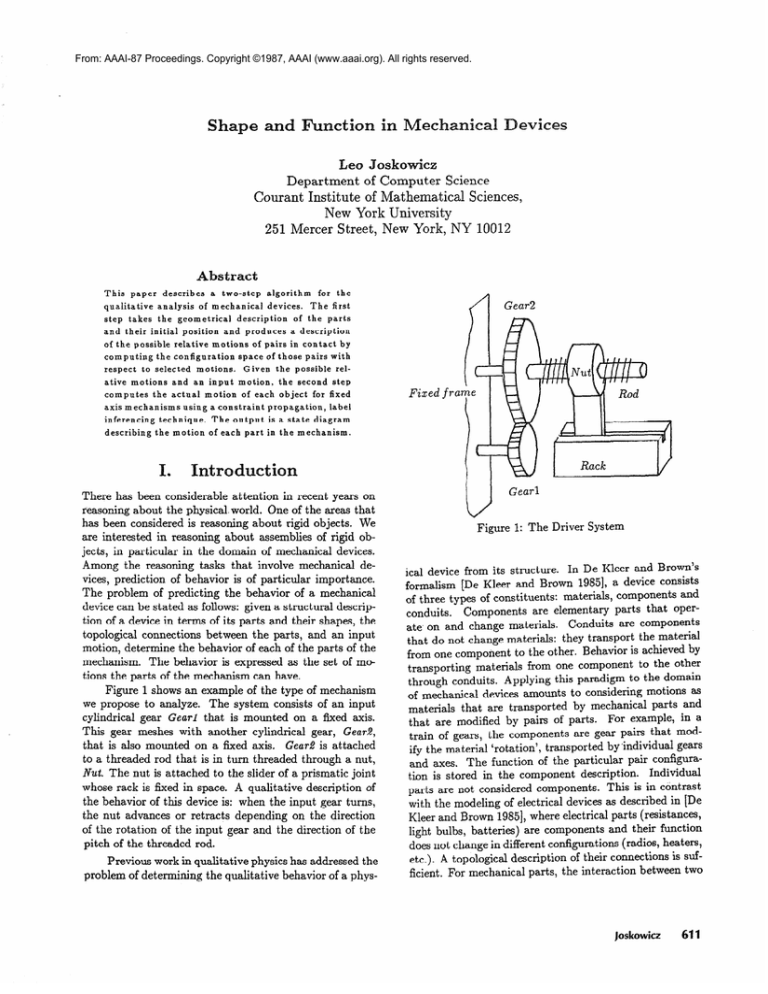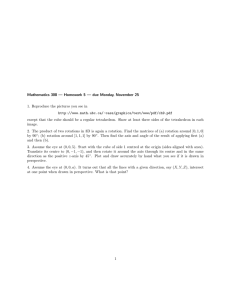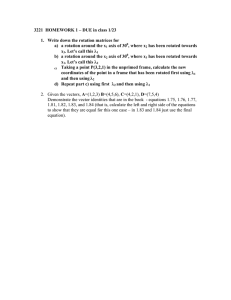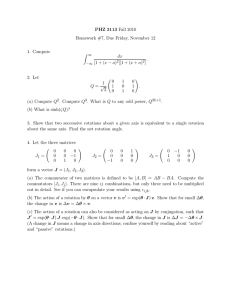
From: AAAI-87 Proceedings. Copyright ©1987, AAAI (www.aaai.org). All rights reserved.
of Computer
Science
Institute of Mathematical
Sciences,
New York University
251 Mercer Street, New York, NY 10012
Department
Courant
Abstract
This
paper
describes
a two-step
qualitative
analysis
step
the
geometrical
initial
position
takes
and their
of mechanical
algorithm
devices.
description
and produces
for
The
of the
the
/I
first
parts
Gear2
a description
of the possible relative motions of pairs in contact by
computing
the configuration
space of those pairs with
respect
ative
to selected
motions
computes
motions.
Given
the possible
rel-
and an input
motion,
the second
step
the actual
motion
of each
object
for fixed
axis mechanisms
using a constraint
inferencing
technique.
The output
propagation,
label
is a state diagram
describing
in the mechanism.
the motion
of each part
Fixed fra
‘$
Gear1
Figure
of rigid ob-
1: The Driver
System
ical device from its structure.
In De Kleer and Brown’s
formalism [De Kleer and Brown 19851, a device consists
of three types of constituents:
materials, components and
Components
are elementary
parts that operconduits.
ate on and change
materials.
Conduits
are components
that do not change materials: they transport the material
from one component to the other. Behavior is achieved by
transporting
w-v--
“*a
Fig
materials from one component to the other
through conduits. Applying this paradigm to the domain
of mechanical devices amounts to considering motions as
materials that are transported
by mechanical parts and
that
are modified by pairs of parts.
For example, in a
train of gears, the components are gear pairs that modtransported by ,individual gears
ify the material ‘rotation’,
and axes. The function of the particular pair configura-
tion is stored
in the component
parts are not considered
description.
components.
This
Individual
is in contrast
with the modeling of electrical devices as described in [De
Kleer and Brown 19853, where electrical parts (resistances,
light bulbs, batteries)
are components
and their function
does not change in different configurations (radios, heaters,
etc.). A topological description of their connections is sufficient.
For mechanical
parts, the interaction
between
joskowicz
two
611
gears is different
from the interaction
between
jects
must be defined
in advance.
Since the number
possible objects
is very large (small
etry of objects
can lead to radically
an exhaustive
Qualitative
same limitations.
Theory
of
changes in the geom-
list of such relations
Process
I.
a worm gear
and a gear, leading to a different type of behavior.
This
requires that all the relations between two particular ob-
different
behaviors),
is implausible.
Forbus’
[Forbus 19851 suffers from the
A more general model that supports
ge-
Local
Interactions
We categorize pairs of objects in contact (kinematic pairs)
following Reuleaux’s classification [Reuleaux 18761. Two
objects
in contact
can form either a lower pair or a higher
pair. Lower pairs are pairs in which the contact between
the two objects takes place along a surface. Higher pairs
are pairs in which the contact takes place along a line or
a point. There are only six types of lower pairs, as illustrated
in Figure
Quantitative geometrical reasoning about moving objects has been studied in relation to the motion planning
typical
higher pair is the pair formed
et aZ., 19871 and [Lozano-Perez
19831.
Given an initial and a final postion of the objects, the goal
predicate
is to find a set of movements in space that describe the
path (if such a path exists) from one position to the other.
Finding the possible behaviors of the parts of a mechanism
along an axis parallel
ometrical
problem
reasoning
is required.
[Schwartz
allel gears.
the parts.
II.
An algorithm for the analysis
of mechanisms
We propose a two-step algorithm
nisms. First, given a geometrical
and their initial positions,
for the analysis of mechadescription of the objects
Local Interactions
Analysis
the possible relative
motions
of all pairs of objects
in contact.
relative
motions
Possible
are expressed
(such as rotates(A,
object A), and a set of algebraic
ters that indicate
The second
possible
between
the actual
classes of mechanisms
motions
motion
Analysis.
and an input
of each object.
are distinguished
and movable axis mechanisms.
mechanisms are those mechanisms
parame-
both motions.
Interactions
relative
mo-
parameter) for
relations between
step is the Global
it determines
axis mechanisms
a&(6),
the dependencies
Given the pairwise
Two
in contact
in terms of a small set of parametrized
tion predicates
motion,
of objects
here:
fixed
Fixed axis
for which rotary axes do
higher
that
is,
pairs.
A
by two meshing par-
For each lower pair there is a simple motion
that
describes
the possible
For example,
relative
the
possible
motions
if A and B form a prismatic
to 0, this relation
0 _< Xa + Xb 2 1 Zength(A, 0) -
relative
motion
of
pair
can be stated as:
0, Xb)
Zength(B, 0) 1
of
A is a trans-
lation along axis 0 by a distance Xa, and that of B
The
is a translation
along axis 0 by a distance Xb.
inequality
involving
Xu and Xb must always be satthe
isfied where Zength(A, 0) denotes
prismatic
section
of A along axis 0.
length of the
The relations
for revoZute(A, B, 0), heZicaZ(A, B, 0), cyZindric(A, B, 0),
spheric(A, B, point) and planar(A, B, plane) are similarly
defined.
finds
that are
many
prism(A, B, 0) M
translation(A, 0, Xa), translation(B,
can be viewed as finding the set of all the possible paths
the parts of a mechanism can have and the relationships
between these paths. This has been shown to be possible
in principle, but only very specific simplifying cases have
been fully analyzed [Schwartz et al., 19871.
2, and infinitely
To find whether
pute the configuration
two parts form a lower pair, we comspace of the translation
and rotation
of A with respect to B which is fixed, as defined in [LozanoPerez
19831. Th e configuration
A with respect
to a fixed object
space of a moving
object
B is the set of all the po-
sitions of A such that A does not overlap
with B. Figure
2 shows the configuration
spaces (properly projected)
for
each one of the lower pairs. Two parts form a lower pair
if their configuration
space is one of the six configuration
spaces shown in this figure.
If the resulting
space is a point, then the two objects
Objects
are assumed
that can be described
configuration
are attached.
to be three dimensional
by the union, intersection
objects
and dif-
not move in space (the Driver System for example). Movable axis mechanisms have at least one rotary axis that
moves in space (such as linkages).
For fixed axis mcchanisms, we build a constraint propagation
network where
each object is represented as a node, and each pairwise relation as a constraint edge between two objects. The initial
motion is propagated as a label in the network, and nodes
ference of simple forms such as cylinders, cones and polyhedra, as in Constructive
Solid Geometry.
A three dimensional object has six degrees of freedom in space and
therefore its configuration space with respect to other fixed
objects is 6-dimensional.
Since it is impractical to compute
are labeled with possible motion predicates according to
the pairwise relations. When the propagation
halts, each
node has a label that corresponds to the motion(s)
of the
object represented by the node. For movable axis mech-
rotation along a particular axis. By computing the configuration spaces for a small number of axis, and taking
anisms,
we provide
a heuristic
bound on the degrees of freedom
rule to determine
a lower
of the entire mechanism.
the full g-dimensional
space, we compute the two dimensional configuration
space with respect to translation and
unions and intersections of them, we find the configuration space of the pair. This is a heuristic method since it
depends on the right choice of axes to analyze. It is valid
for all lower pairs except
The
recognition
the helical one.
of higher
pairs does
to a general method as the one described
approaches are suggested here: a functional
612
Engineering Problem Solving
not lend itself
above.
Two
approach and
isa(cyZindricaZ,gear(A)),
isa(cyZindricaZ-gear(B))
size-of-teeth(A)
= size-of-teeth(B)
fixed(axis-ofrotation(
A)),
f ixed(axis-of rotation(B))
paraZZeZ(axis-of rotation(A),
axis-of rotation(B))
distance(origin( A), origin(B))
= radius( -4) +
radius(B)
are satisfied,
then the relation
between
the possible
mo-
tions is:
rotation(A,
axis-of-rotation(A),
rotation( B, axis-of
9 A=-eB
I
rotation(
origin(A),
0,)
B), origin(B),
e
BB )
xnumber-of-teeth(A)/number-of-teeth(B)
and objects
A and B are said to form a parallel gear pair.
For unknown higher pairs, several rules can be used to
deduce the differential
tegral behavior
behavior
of the two parts.
Their in-,
can then be deduced from their differential
behavior. The analysis at the differential level consists of
determining the behavior of the two parts at the next in-
3
A
lz
(c) Helix
(b) Line
(a) Circle
:-rll
(I)
(e) Sphere
(d) Cylinder
(f)
finitesimal instant. The analysis at the integral level determines the behavior over a period of time. The predicates
for lower and higher pairs shown before p-ism(A, B, 0)
and paraZZeZ_gears(A, B) d escribe both integral behaviors.
It is possible to infer the differential and integral behavior
of a higher pair using a set of differential behavior rules
for solid objects.
To illustrate
how such an analysis
the relation
gument
between
two parallel
can be used:
Let
gears.
lar path by a distance
3D Space
six lower pairs: (a) revolute (b) prism (c)
helical (d) cylindric (e) sph eric (f) planar and their configuration space
of dl.
Since
Tb and there are no obstacles
same distance
Tu is in contact
that interfere
of both
gears.
be in contact,
dl. This constitutes
By determining
we can integrate
ior during an interval
with A, in opposite
-e8
approach.
are described
In the functional
by properties.
approach,
For example,
objects
a gear can be
approximated
by a cylinder with a number
such as the number of teeth, radius, etc:
of properties
cylindrical-gear(G)
is defined by the properties
radius(G), origin(G), cyZinder( G),
number_of -teeth(G), sire-of -teeth(G),
axis_of rotation(G),
beZongs(origin(G) , axis-ofrotation(
ar-
contact, where Tu belongs to gear A and Tb belongs to gear
B. A rotation of gear A causes 2% to move along a circu-
2: The
a differential
The following
5% and Tb be the two teeth in
tion of B, Tb will move along another
Figure
can
be made, suppose we want to infer (and not just to state)
G))
circular path by the
the differential
how long
behavior
Ta and Tb will
this behavior.
The behav-
of time I is that B rotates
directions
together
by an angle of 8, that equals
x number_of -teeth(A)/number-of-teeth(B).
and Tb’ be the two teeth following
rection
of the motion
Therefore
Let Ta’
Tu and Tb in the di-
of A and B respectively.
and Tb’ are part of A and B, they
respectively.
with
with the mo-
move
they will be in contact
Ta’
Since
A and B
with
before
Ta
and Tb stop being in contact (assuming the spacing between teeth is such that this is true). Another integration
of behavior can now be based on symmetry arguments; B
will turn when A turns in opposite directions.
The same
angle relationship as described above will hold for any time
interval
I. We thus obtain
the relation
for parallel
gears.
A higher pair is then described as a predicate that
relates two functionally described objects. Two cylindrical
gears that are mounted in parallel can be described by the
This argument is made more precise by using a set ofmles
that support this deduction. An example of such a rule is
the differential
Contact
parallel-gears(d,
is transmitted
between
B) predicate.
If the preconditions:
Rule.
This rule states how a force
two planar surfaces:
joskowicz
613
Contact
Rule:
let S1, S& be two planar surfaces of two distinct objects 01 and 02 in contact.
Let N1, N2 be the two normals to the point
(or surface)
of contact
of S1 and SZ respectively.
Then if a force is applied to 01, it will be transmitted to 02 in the direction of the normal to
the point (or surface) of contact, provided that
01 can move in the direction of the force (assuming no obstacles and forces greater than friction).
Using this set of rules, with additional
geometrical
ing, we showed how to deduce the behavior
reason-
of a worm gear
meshed with a cylindrical gear. Although this method is
not general, it can be used in some simple cases, especially
in the domain
pairs can be either simple or complex.
Sim-
ple pairs are the ones described above i.e. those who have
a single state corresponding
to a single relative qualitative
A complex
pair is a pair that is described
fireQ_a.zis(GearZ,
Fixed
02)
is represented
by a local state.
Figure
3:
The
initial
constraint
network
for the Driver
translation,
fixed, undeter-
Sys tern
by
several simple pairs, each corresponding
to a different relative qualitative behavior. Each possible relative qualitative behavior
01)
of gears.
Kinematic
behavior.
v--7
fizrerlaxis(Gearl,
A local state
motions
of the part (rotation,
mined, etc.) and their constraints.
relations between pairs of objects
The constraints are the
found in the Local In-
is created by a change in the contact points or surfaces
between the two parts. Each new local topology is analyzed as a simple pair, and the transitions between states
teraction Analysis (paruZZeLgears(A,B), prism(A,B),
etc.).
A dummy node is introduced to represent the ‘source’ of
are conditions on the positional parameters of the objects.
The resulting collection of states and transitions is called
the local state diagram for the kinematic pair.
fied,axis or undetermined except for the input node which
is labeled with the initial motion. Figure 3 shows the con-
The output of the Local Interactions Analysis is a set
of local state diagrams containing relative motion predicates, one for each pair of objects originally in contact.
This description corresponds to a functional description of
motion is propagated by starting at the input node, and
examining all its successors. The new labeling of a suc-
the kinematic
ject, as found in the constraint.
IV.
pairs.
Global
Given the pairwise
motion,
Interactions
possible
relative
the Global Interactions
behavior
of the mechanism
individual
parts.
the propagation
Analysis
motions
Analysis
and an input
task is to find the
in terms of the motions
of its
We will first provide an algorithm for
of motion for mechanisms in which axes
of rotation do not move in space (they are spatially fixed).
We will then analyze the criteria necessary for mechanisms
in which axes move in space.
A.
Motion Propagation Algorithm
fixed axis mechanisms
We will first consider mechanisms
single local state (simple
for which each pair has a
pairs), and whose global topology
does not change as the parts move.
mining
the motions
for
The problem
of deter-
of all the parts of a mechanism,
given
an initial input motion, can be viewed as a constraint propagation, label inferencing problem.
Given a set of terms
with initial labelings and a set of constraints relating the
terms, the goal is to find a final term labeling that is consistent with the constraints.
Global Analysis
the mechanism.
614
A constraint
network
for the
is built by having one node for each part in
The labels are the possible parametrized
Engineering Problem Solving
the input
motion.
straint network
All
nodes
are initially
for the mechanism
labeled
in Figure
fixed,
1. The input
cessor is determined by intersecting the label found in it
(including its bounds) with the possible motion of that obIn the example
of Figure
3, the input motion is rotation(I, 0, f?), the initial labeling of Gear1 is fied-axis(Gear1,
0), and the relation between I and Gear1 is attached(I,
motion{ Gearl)).
motion(Gear1)
rotation(Gear1,
is rotation(Gear1,
(i.e motion(I)
is rotation(I,
0, 0) for GearI.
*
0, 4) and
0, e), the intersection
0, 0) and fixed-axis(Gear1,
new label, rotation(Gear1,
tion between
Gearl)
S ince motion(I)
of
0) yields the
The
intersec-
two possible motions is defined in intersection
rules such as the following:
and rotation(A, 0, 8,)
tersection of them is:
let L be the label of an object
its possible
motion.
Then
if L = rotation(A, O,eL ) or f ixedlzxis(A,
then rotation( A, 0, eA ) and
n restrictions
restrictions(8,)
else (when 6’ rf 0) 0
the in-
0)
. *-
else if L = transZation(A, O’, Xa) then 0
else if L = undetermined(A)
then rotation(A,
0, eA Iand restrictions(8,)
else if L = fixed(A)
then fixed(A)
The algorithm
propagates
the motion in a Breath
First Search manner to all nodes. If a label modification
occurs for a node, the node and all its neighbors are added
to a list of nodes to be updated. The algorithm stops when
this list is empty, i.e when the node labels cannot be modified any further.
For each part,
the label represents
the
possible motion of the object and its relation (via parameters) to the motion of the neighboring parts. The output
is n single global state that contains the behavior of each
part.
This algorithm
This algorithm
nisms that have
states consisting
sitions between
bination of the
has been implemented
can be extended
in Franz Lisp.
to deal with mecha-
complex pairs by building a set of global
of the cross product of local states. Tranglobal states are constructed as the comlocal transitions.
To find the behavior of
each part in a global state, each global state is analyzed
using the algorithm described above. Some global states
and transitions will be detected as infeasible, and thus be
deleted
to determine
from the global state graph.
Different
global states can also be produced
by
changes in the topology of the mechanism when new contacts between parts are created or when old ones disappear. After the motion propagation
algorithm has been
v,
the degrees of freedom
Conclusions
relative motions of pairs of object initially in contact, producing a functional description of the kinematic pair. We
have provided an algorithm for the global analysis of fixed
axis mechanisms based on a constraint
inferencing technique and a heuristics
flect the possibility of simple motions. This decomposition
can later be used to construct the state diagram of the
mechanism for a given initial position and input motion.
cknowledgments
I wish to thank
helping me clarify
motion
envelopes
intersect,
means that the bounds
of each part. If two or more
a new contact
of the motions
is created.
state
and the new one is specified
on the positional
contact.
The
parameters
resulting
the state diagram
state diagram
and to the graph of transitions
explain
the behavior
is similar
in [Forbus
to
19851
19851 used to
of a physical system.
echanisms with movable axes
0
The
that came into
in [De Kleer and Brown
algorithm
described
in the previous
be generalized
for mechanisms
the combination
of two simple
lation
,etc,)
can still
motion.
be applied
and Ernest
Davis
for
in this paper.
eferences
[De Kleer and Brown 19851 Johan de Kleer and John. S.
Brown. A Qualitative
Physics based on Confluences
In Qualitative Reasoning about Physical Systems D.
Bobrow
editor,
MIT
Press 1985 1985.
[Forbus 19851 K en F or b us. Qualitative Process Theory In
Qualitative Reasoning about PhysicaZ Systems D. Bobrow editor,
[Lozano-Perez
MIT
Press 1985
19831 Tom&s Lozano-Perez.
Spatial
Plan-
IEEE
Truns-
ning: A Configuration
Space Approach
actions on Computers
Vol. C-32, Number
2, pp 108-
120, 1983.
cannot
with movable axes since
motions (rotation,
trans-
can result in a complex
less, the algorithm
section
Addanki
the ideas presented
This
as a condition
of the objects
global
produced
Sanjaya
of the parts must
be updated by propagation in the constraint network. The
new contacts are analyzed locally as new pairs are created and a new constraint graph is built to correspond to
the new global state. The transition between the current
global
propagation,
label
for the analysis of
movable axis mechanisms.
We are presently working on a formalization
of the
problem in terms of a decomposition
of the configuration
space into a set of disjoint connected regions that will re-
object
while moving)
and futpmre work
We have presented a two step algorithm for the analysis of
mechanical devices. The first step computes the possible
executed, topological changes can be detected by computing the motion envelope (all the positions in space that an
occupies
of a mechanism.
Neverthe-
to the parts
of
the mechanism with fixed axis, isolating the parts that
have movable axes. A possible criteria for movable axes
is the Kutzbach criteria [Shigley and Uicker 19801, originally developed to determine the mobility of linkages. This
criteria gives a lower bound on the number of degrees of
freedom a mechanism has, based solely on the number of
[Reuleaux
18761 Franz Reuleaux.
chinery:
The Kinematics
Outline of a Theory of Machines
in 1876, Reprinted
by Dover Publications
of Ma-
Published
Inc, 1963.
[Schwartz et al., 19871 J acob T. Schwartz, Micha Sharir
and John Hopcroft.
Planning, Geometry and Complexity of Robot Motion Ablex Series in Artificial
telligence, Ablex Publishing Co., 1987.
[Shigley and Uicker 19801 J.
Theory
of Machines
E.
Shigley
and
and Mechanism
In-
J. Uicker.
McGraw-Hill
Inc, 1980.
links, the number of higher pairs and the number of lower
pairs.
For a planar
mechanism,
the degree of mobility
is:
M = 3(n - 1) - Jh - 2 JZ where n is the number of links, Jh
is the number of higher pairs and JZis the number of lower
pairs.
M is a lower bound since, depending
sions of the objects,
no effect on constraining
anism.
Note
that
the degrees of freedom
the links are considered
rods, with their actual shape not playing
analysis.
on the dimen-
some links can be redundant
The Kutzbach
criteria
and have
of a mech-
to be simple
any role in the
is best used as a heuristic
joskowicz
615





